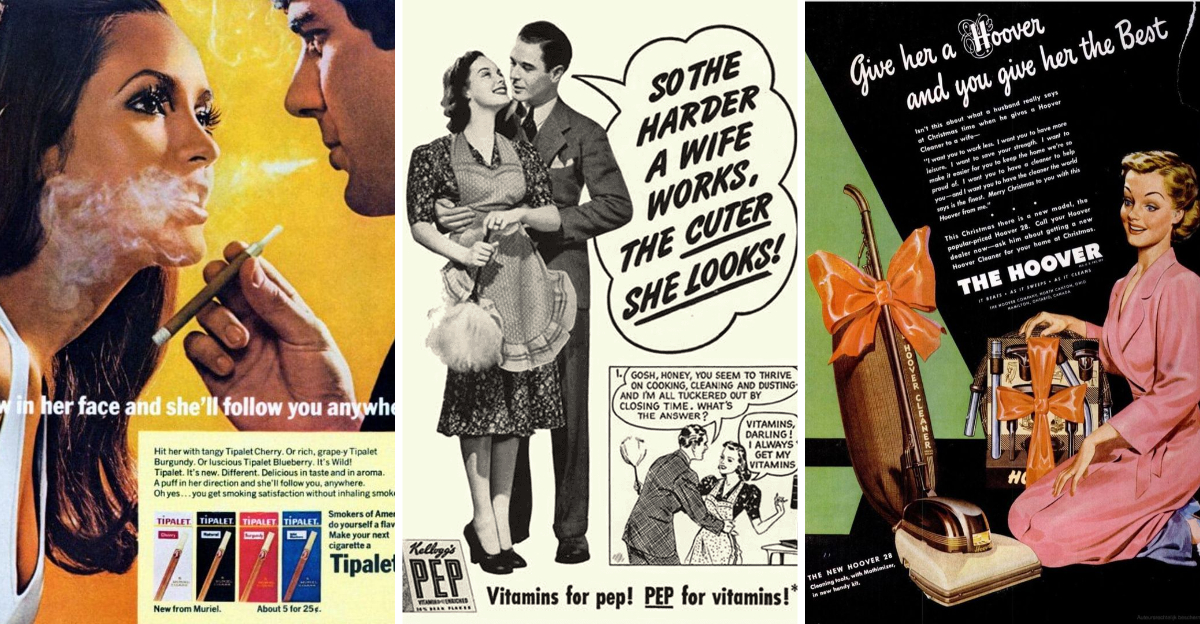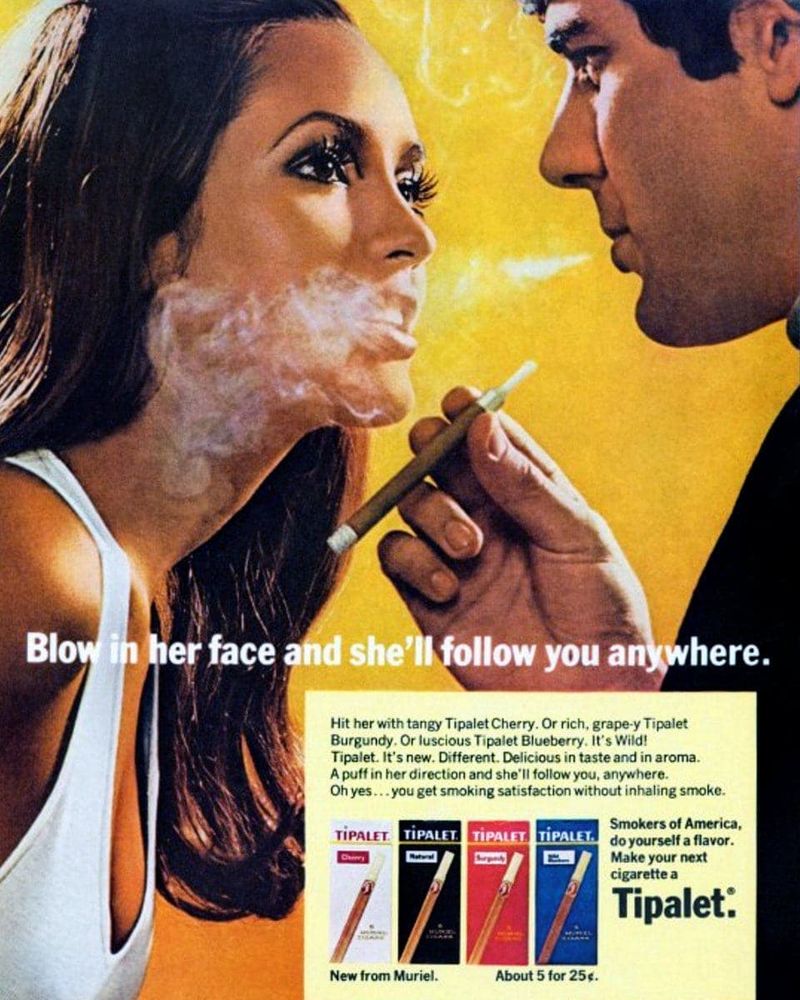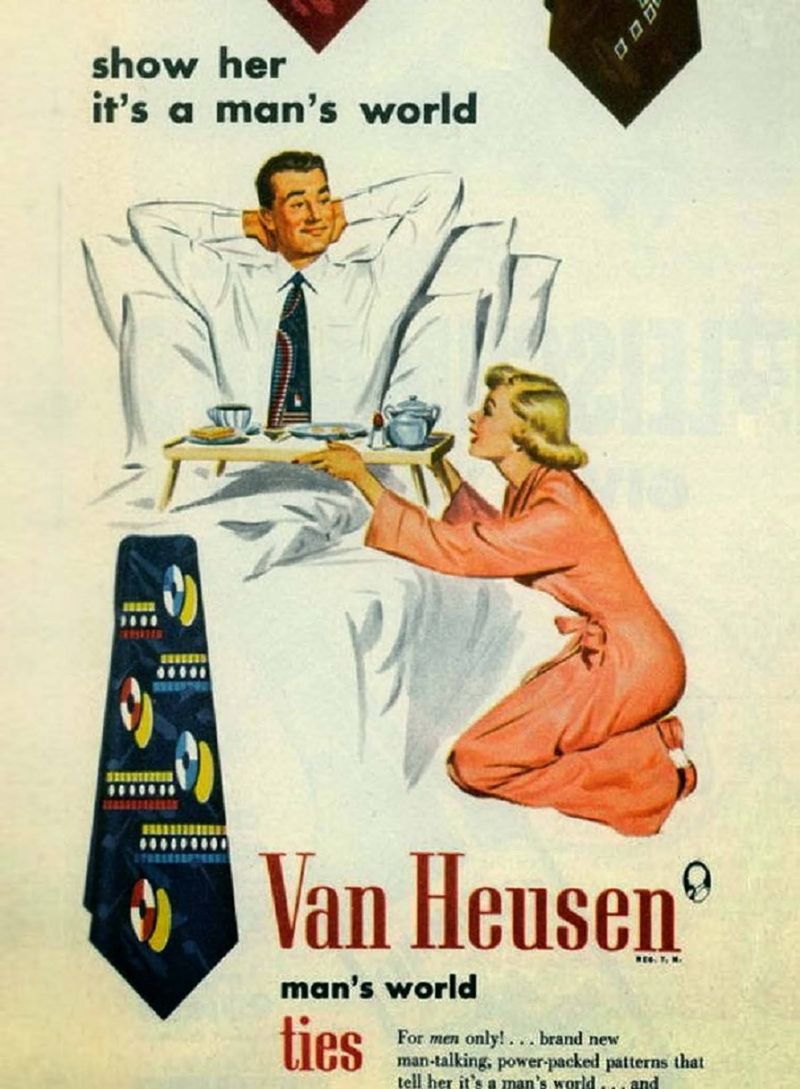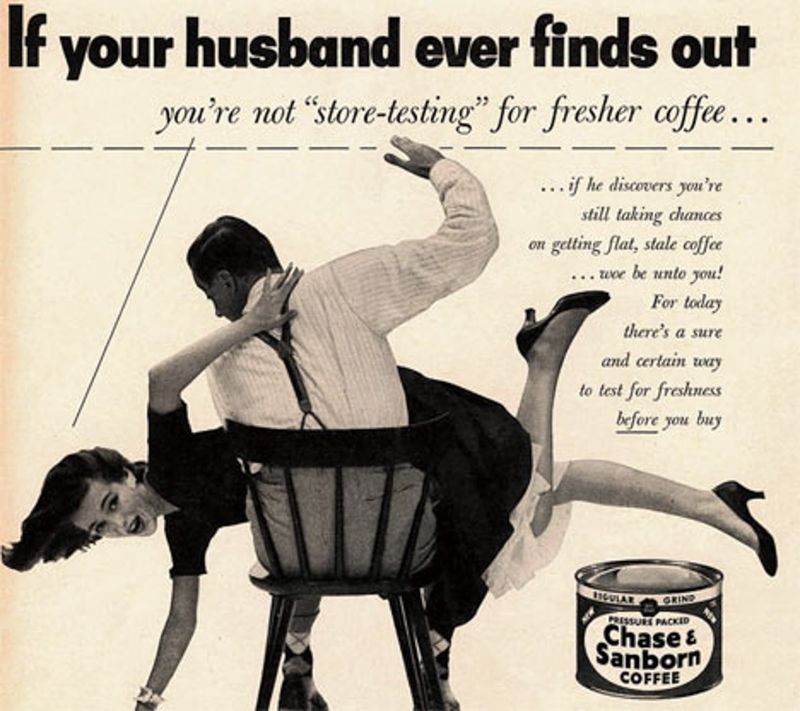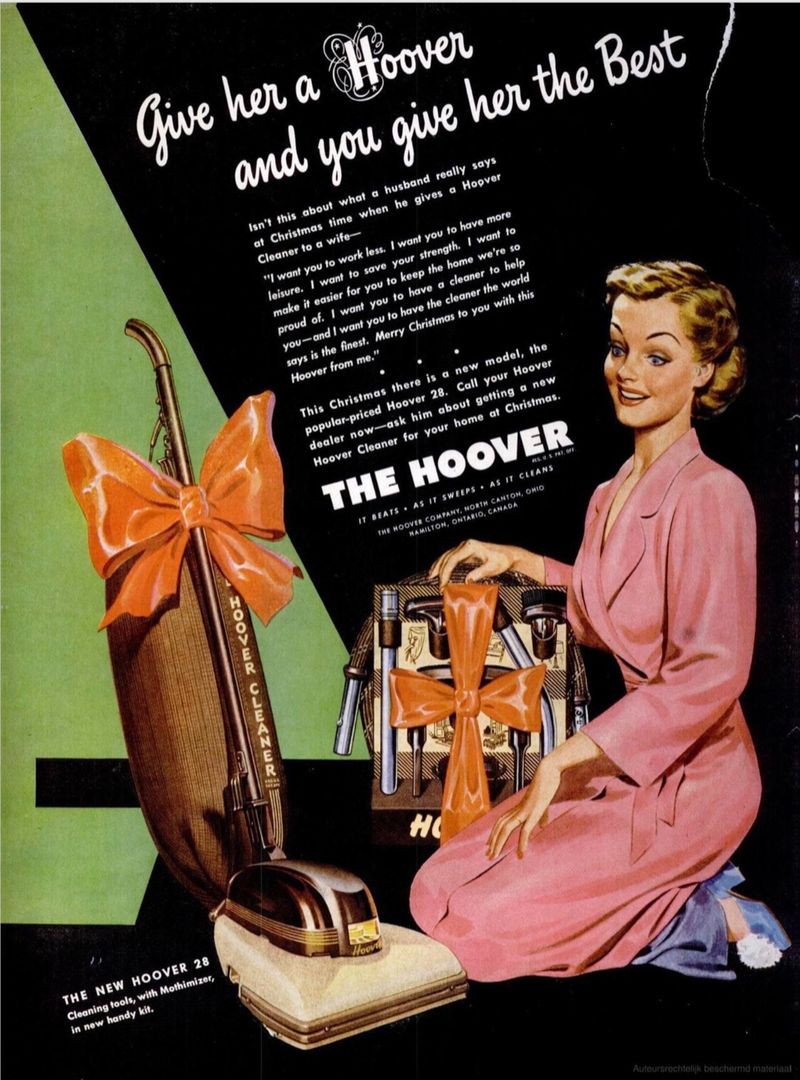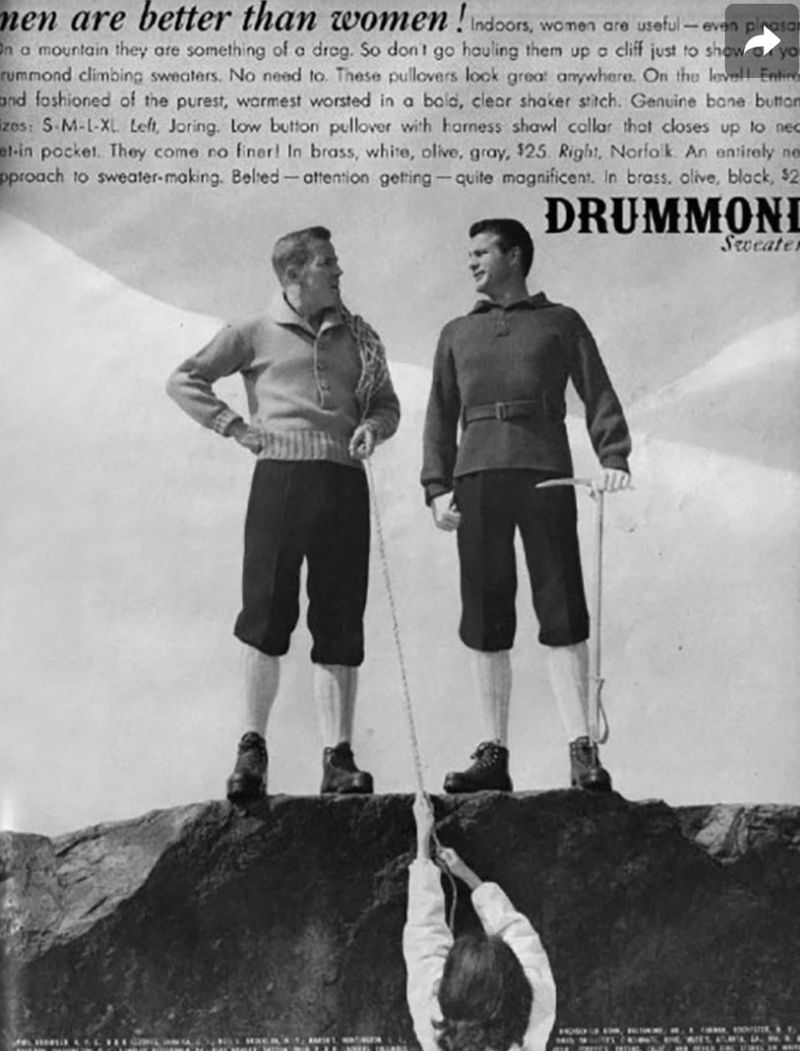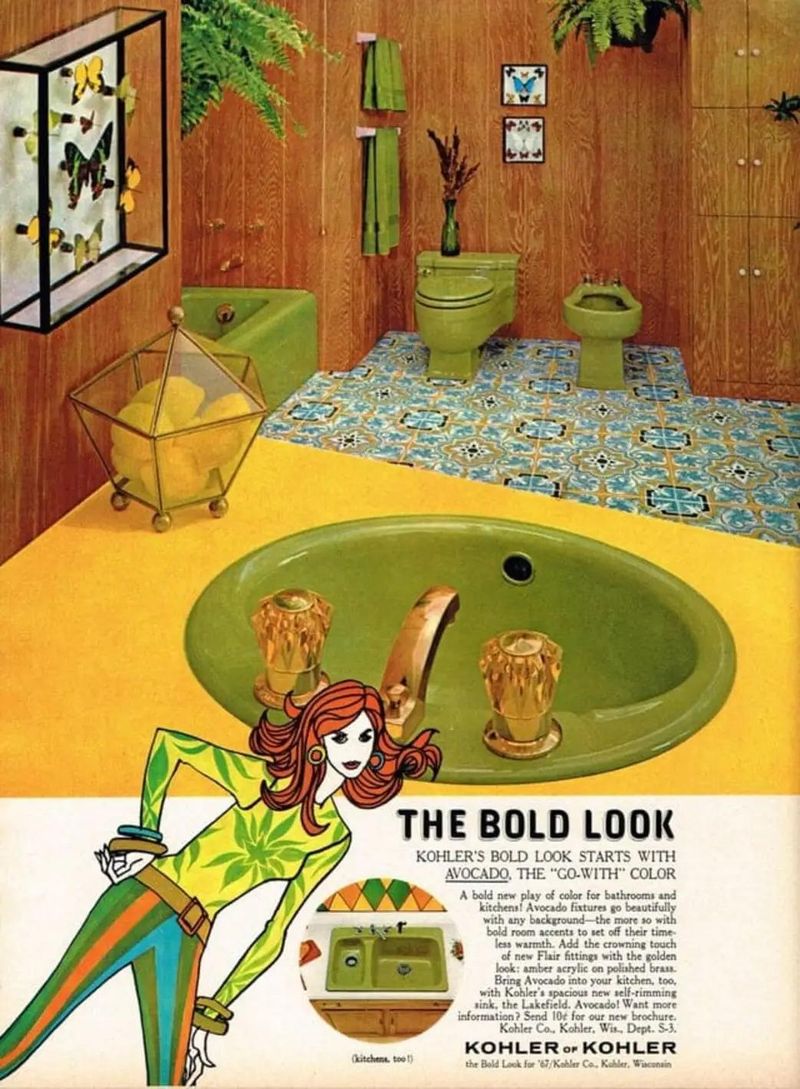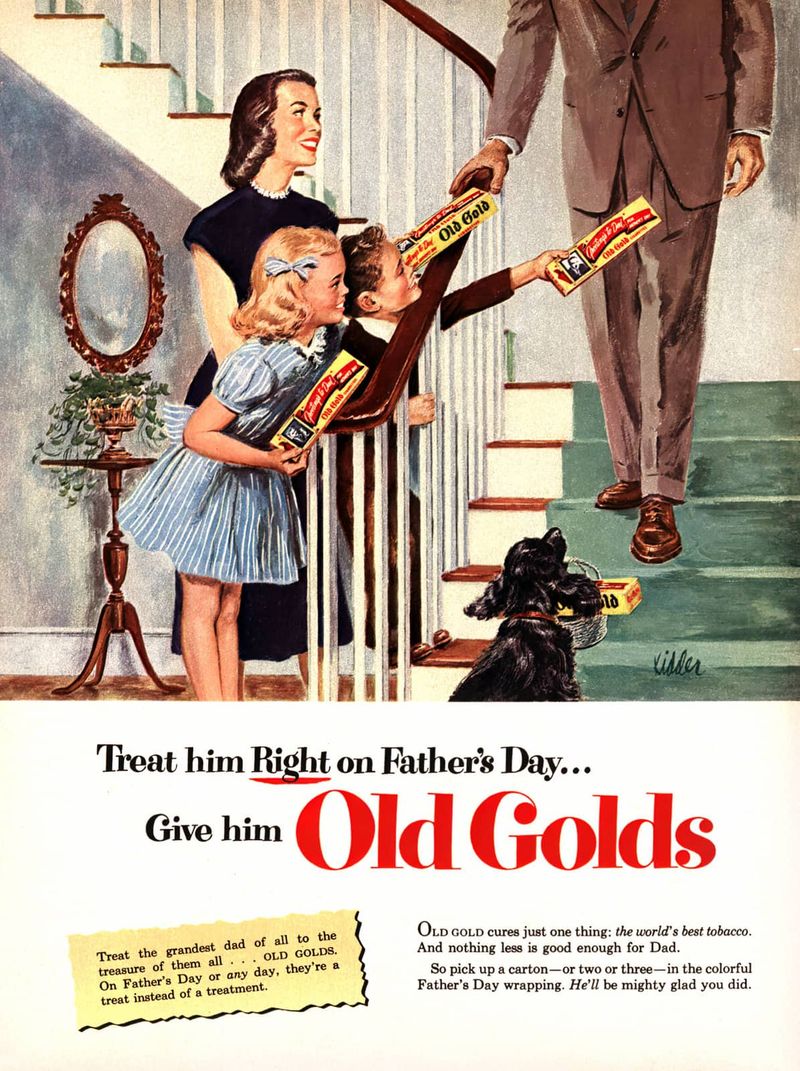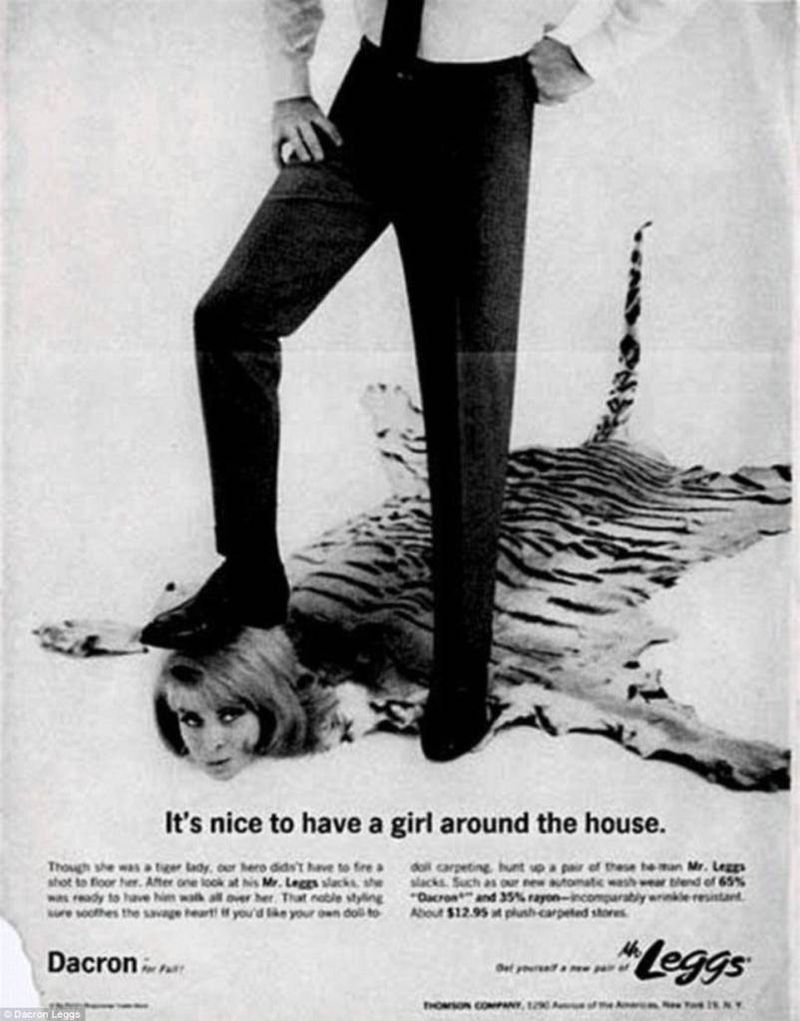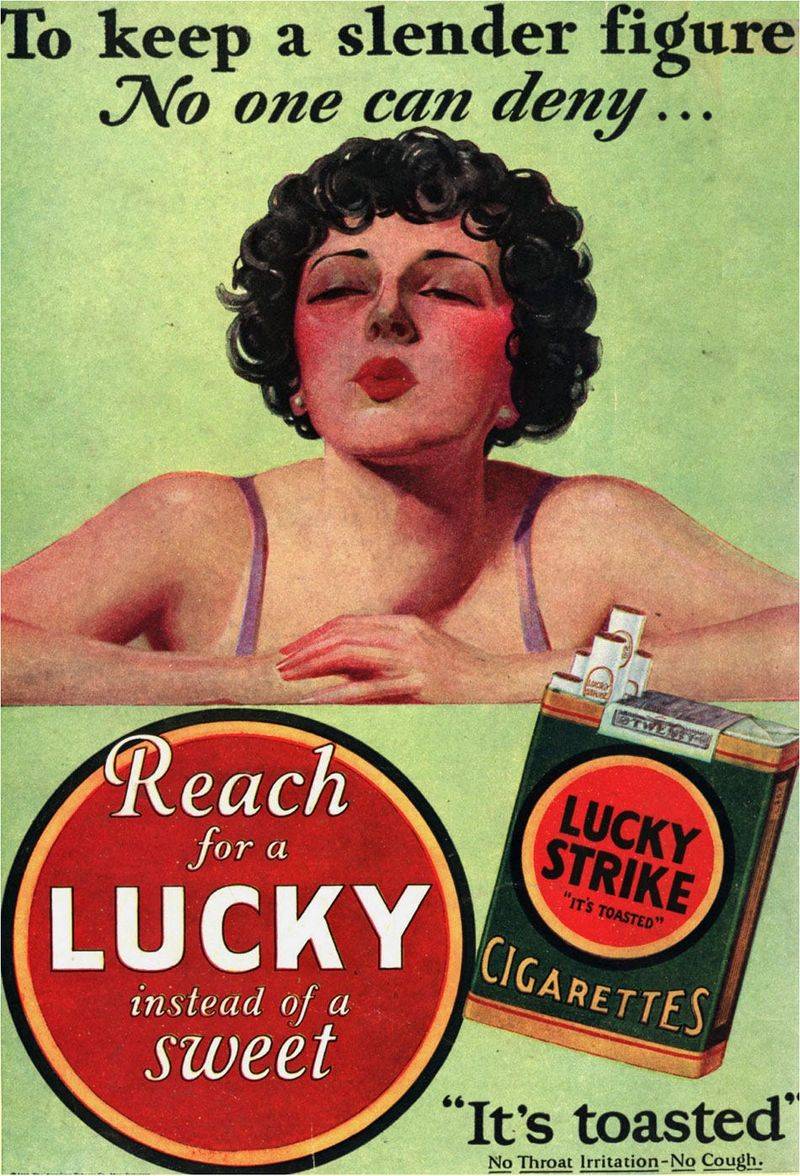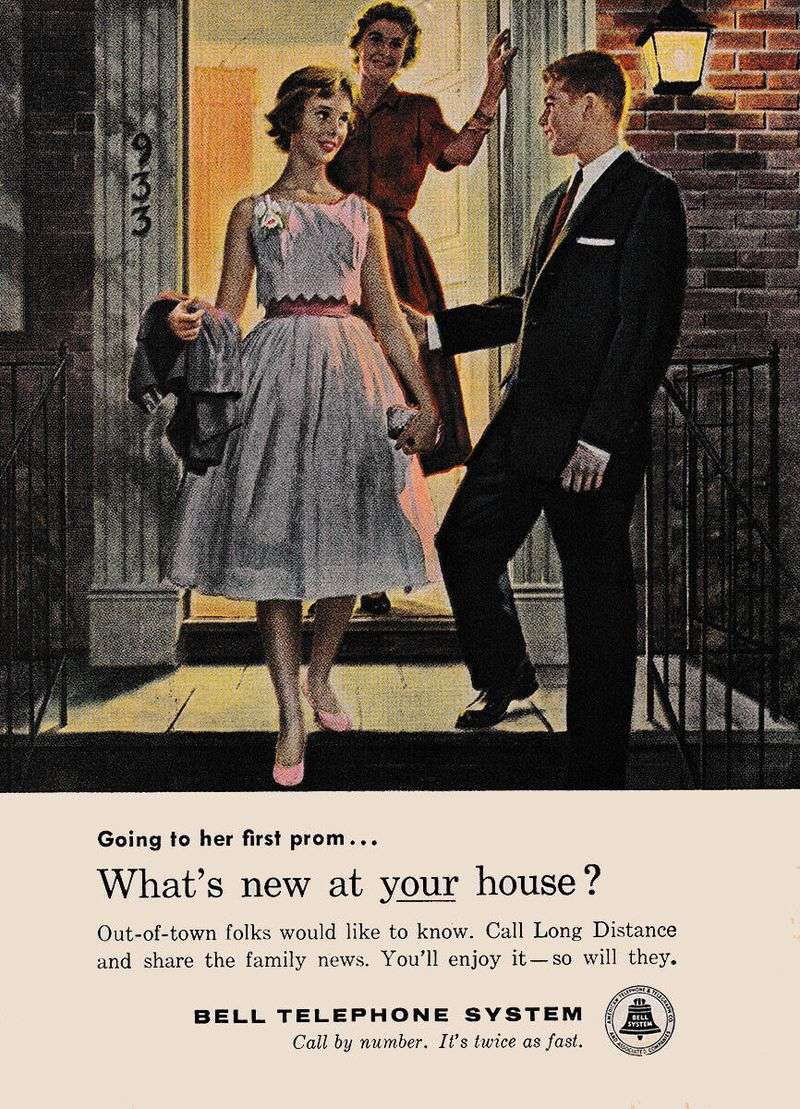Explore a collection of vintage advertisements that highlight the cultural norms and attitudes of past generations. These campaigns, while nostalgic, often reflect perspectives that are quite different from today’s standards of awareness and sensitivity. Through these ads, we see a snapshot of how society viewed various issues ranging from gender roles to racial stereotypes. Each campaign offers a glimpse into the mindset of an era where certain biases and misconceptions were commonplace. This blog post delves into twenty such ad campaigns, shedding light on how far we’ve come and offering insights into the values that dominated the era of the Baby Boomers.
Tipalet Cigarettes – ‘Blow in Her Face’
The 1970s Tipalet cigarette ad campaign takes a bold approach, focusing on the act of blowing smoke into a woman’s face. This advertisement boldly suggests that such a gesture would make the man more appealing. The imagery and wording highlight the era’s lack of awareness around personal space and consent. In today’s terms, this approach would be considered both invasive and disrespectful. The ad captures a moment in time when masculinity was often portrayed as assertive, sometimes at the expense of acknowledging a woman’s autonomy. Such campaigns remind us of societal norms that have thankfully evolved.
Van Heusen – ‘Show Her It’s a Man’s World’
The Van Heusen “Show Her It’s a Man’s World” campaign from the 1950s epitomizes the gender roles prevalent in that era. The ad features a man comfortably lounging while his wife dutifully serves him breakfast in bed. This imagery reinforces the notion that a woman’s place was primarily in service to her husband. The message, while stark, captures the cultural norms of a time when male dominance was celebrated and unquestioned. Such ads serve as a stark reminder of how gender dynamics have shifted, promoting equality and mutual respect in modern relationships.
Chase & Sanborn Coffee – ‘If Your Husband Ever Finds Out’
Chase & Sanborn’s infamous 1960s ad campaign warns women about their husband’s potential wrath if the coffee isn’t up to par. The ad features a nervous housewife, emphasizing the pressure on women to meet domestic expectations. This portrayal underscores the gender imbalance and the fear-based tactics used to sell products. Such advertisements reflect the societal acceptance of controlling dynamics within relationships. Today, this kind of messaging would be criticized for perpetuating harmful stereotypes, but it serves as a historical lesson on the impact of advertising in shaping societal norms.
Kellogg’s Pep – ‘So the Harder a Wife Works’
The Kellogg’s Pep campaign from the 1940s portrays a cheerful housewife, tirelessly working in the kitchen, promoting the idea that hard work is rewarded with a bowl of cereal. The ad suggests that the more a wife works, the more she deserves this simple reward, echoing the unwavering gender roles of the time. This reflects a cultural norm that placed domestic labor on women’s shoulders without recognition or compensation. These campaigns highlight an era where appreciation was measured by small gestures rather than equality. It’s a stark contrast to today’s efforts toward acknowledging and sharing domestic responsibilities.
Hoover – ‘Christmas Morning’
Hoover’s 1950s “Christmas Morning” campaign presented the vacuum cleaner as the perfect gift for a wife, encapsulating the societal norms around domestic duties. The joy depicted on the woman’s face as she receives a household appliance is telling of the times when housework was primarily seen as a woman’s responsibility. This advertisement perpetuates the notion that gifts for women should cater to their domestic roles, rather than personal interests or aspirations. Such advertising serves as a historical reflection on how consumer culture mirrored and reinforced traditional gender roles in family settings.
Alcoa Aluminum – ‘You Mean a Woman Can Open It?’
The Alcoa Aluminum campaign of the 1950s plays on the stereotype of women as less capable by expressing surprise that a woman could open a jar. This ad suggests that the packaging innovation was remarkable merely because it catered to women’s perceived lack of strength. The exaggerated expressions play into the gender biases of the time, where strength and competence were often associated with men. Such campaigns underline the pervasive stereotypes in advertising, reflecting a bygone era’s attitudes that underestimated women’s abilities and reinforced limiting gender roles within the household.
Drummond Sweaters – ‘Men Are Better Than Women!’
Drummond’s 1960s sweater campaign boldly declared “Men Are Better Than Women!”—a statement that captures the blatant sexism prevalent in advertising. The ad features a man modeling a sweater, using his appearance to underscore an absurd claim of male superiority. Such messaging was not uncommon, as advertisements often reinforced patriarchal norms where men were portrayed as inherently superior in ability and intellect. These campaigns serve as a reminder of the pervasive gender inequality accepted at the time. Today, such statements are rightly challenged as outdated and discriminatory, reflecting a societal shift towards equality.
Schlitz Beer – ‘Don’t Worry Darling, You Didn’t Burn the Beer!’
The Schlitz Beer ad from the 1950s humorously reassures wives concerned about burnt dinners by focusing on the beer, not the meal. Featuring a husband comforting his wife, the campaign trivializes cooking mishaps while emphasizing beer as the essential component of dinner. This reflects the era’s gender dynamics, where women’s cooking errors were downplayed while reinforcing the idea that a man’s contentment could be salvaged by beer. Such advertising illustrates the lighthearted yet persistent portrayal of traditional roles within the marriage. Today, these ads are critiqued for their simplistic and gendered views on domestic life.
Kohler – ‘The Bold Look of Kohler’
Kohler’s 1960s “Bold Look” campaign revolutionized bathroom design by associating luxury and masculinity with their products. The ad features a man admiring the sleek, modern fixtures, catering to a male sense of style and authority in home decisions. This approach reinforces the notion that home aesthetics were influenced by male preferences, highlighting the gendered marketing strategies of the time. Such advertisements serve as a lens through which we view shifts in consumer behavior, where design choices reflect broader cultural trends. Today, design is celebrated as a universal interest, transcending gender stereotypes.
Old Gold Cigarettes – ‘Treat Him Right’
The Old Gold Cigarettes campaign from the 1950s encouraged women to “treat him right” by offering cigarettes. This ad underscores a period when smoking was glamorized, and women were urged to cater to men’s desires. The focus on pleasing men through such gestures points to the gender roles that dominated the era, where women’s actions were aimed at satisfying male pleasure. Advertising like this highlights the ways in which consumer goods were marketed through the lens of gender relations. Today, such themes are reevaluated with a focus on individual choice and health consciousness.
Dacron – ‘For the Man Who Cares’
Dacron’s 1960s ad campaign targeted “the man who cares” by associating their suits with sophistication and attention to detail. The imagery features a well-dressed man, promoting the idea that personal grooming and appearance were paramount for successful masculinity. This reflects the cultural expectation of men to demonstrate their status through attire. Such advertisements highlight the pressure on men to conform to societal ideals of professionalism and elegance. Today, while personal style remains important, there’s a broader acceptance of diverse expressions of masculinity, moving beyond rigid stylistic norms of past decades.
Goodyear Tires – ‘If It Wasn’t For Women’
Goodyear’s 1960s campaign humorously attributed tire innovations to women’s driving, reflecting both a lighthearted tone and underlying gender biases. The ad features a couple with a car, subtly implying that women’s perceived lack of driving skills required better tires. This playful jab at female drivers underscores a common stereotype of the time. Such advertisements capture a cultural moment where humor often masked deeper societal views on gender roles. Today, these stereotypes are increasingly challenged as outdated, with a greater focus on celebrating women’s contributions to all aspects of life, including driving.
Kenton Cigarettes – ‘To Keep a Slender Figure’
In the 1950s, Kenton Cigarettes ran a campaign suggesting that smoking was a great way to maintain a slender figure. The ad featured a beautifully dressed woman enjoying a cigarette, with a focus on her slim waistline.
This advertisement reflects the era’s skewed perceptions of health and beauty, where smoking was glamorized and falsely linked to weight management. It’s fascinating to see how such messages were propagated without any consideration for the potential health consequences.
Today, such a campaign would be deemed irresponsible and misleading, as public awareness about the dangers of smoking has drastically increased. This ad serves as a stark reminder of how advertising once prioritized style over substance.
Palmolive – ‘Keep That Schoolgirl Complexion’
Palmolive’s campaign in the 1950s promised women a “schoolgirl complexion,” tapping into the cultural obsession with youthfulness. Featuring a woman using soap, the ad conveyed the notion that maintaining youthful skin was essential for women’s social acceptance. This reflects a time when beauty was often equated with youth, enforcing unrealistic standards for women to aspire to. Such campaigns highlight the pervasive messaging around age and attractiveness. Today, there’s a shift towards celebrating all stages of life, promoting products that enhance natural beauty rather than perpetuating unattainable ideals of eternal youth.
Lux Soap – ‘Nine Out of Ten Stars’
Lux Soap’s 1950s campaign boasted endorsements from “nine out of ten stars,” leveraging celebrity appeal to sell beauty products. Featuring glamorous actresses, this ad played into the allure of Hollywood, suggesting that using Lux could bring one closer to star status. This reflects a period when celebrity influence began to shape consumer behavior significantly. Such advertisements highlight the power dynamics between fame and consumerism, encouraging women to emulate film stars. Today, while celebrity endorsements remain influential, there’s growing skepticism about authenticity, with consumers seeking genuine connections rather than aspirational ideals.
Maidenform – ‘I Dreamed I…’
Maidenform’s 1960s “I Dreamed I…” campaign combined fantasy with confidence, featuring women in surreal settings dreaming of empowerment while wearing their bras. This ad series portrayed women in roles beyond the domestic sphere, offering a glimpse of liberation through fashion. However, it still tied women’s self-worth to physical appearance and desirability. This reflects an era on the brink of social change, where traditional roles began to be questioned. Today, while fashion continues to empower, there’s a concerted effort to ensure that empowerment is linked to personal choice rather than external validation.
Bell Telephone – ‘Long Distance’
The Bell Telephone “Long Distance” campaign in the 1950s emphasized the importance of staying connected with family and loved ones. The ad features a family gathered around a phone, portraying the telephone as a vital tool for maintaining relationships. This reflects a time when technological advances began to shape social interactions, with long-distance calls symbolizing care and connection. Such advertisements capture the societal shift towards valuing communication and the evolving role of technology in everyday life. Today, with digital communication, the essence of staying connected remains, highlighting the enduring importance of relationships.
Brylcreem – ‘A Little Dab’ll Do Ya’
Brylcreem’s iconic 1950s slogan, “A Little Dab’ll Do Ya,” captured the essence of male grooming with a touch of humor. Featuring a man applying the product, the ad promoted the idea that style and grooming were accessible with minimal effort. This reflects a cultural moment when personal appearance became increasingly important for men, aligning with growing consumer interest in men’s grooming products. Such advertisements highlight the evolution of male beauty standards, encouraging attention to personal care. Today, the grooming industry continues to thrive, with diverse products catering to various styles and preferences.
